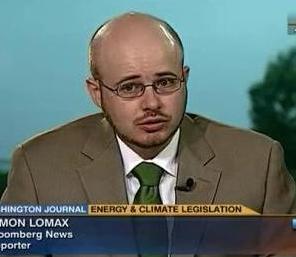Energy In Depth
Background
Energy In Depth (EID) is a program jointly launched by the Independent Petroleum Association of America (IPAA) and the “independent global business advisory firm” FTI Consulting to promote and defend unconventional gas development (fracking). In a October 2014 “Technical Paper,” FTI Consulting outlined how it teamed with the IPAA in 2009 to launch EID as “a research, education and rapid response platform specifically focused on telling the story of unconventionals development.”1“Managing Aboveground Risks: Experience from the United States,” FTI Consulting, October 2014. Archived .pdf on file at DeSmog.
PR Watch reported in 2012 the campaign was effectively a “PR operation for the industry’s multi-billion dollar financial interests in ‘unconventional’ drilling” of natural gas.2Lisa Graves. “‘Energy In Depth’ – A Reporters’ Guide to Its Founding, Funding, and Flacks,” PR Watch, December 28, 2012. DeSmog obtained a leaked memo in 2011 that revealed Energy In Depth “would not be possible without the early financial commitments” of major oil and gas interests including BP, Halliburton, Chevron, Shell, XTO Energy (now owned by ExxonMobil), and several other large oil and gas companies.3Brendan DeMelle. “‘Energy In Depth’ Was Created By Major Oil and Gas Companies According to Industry Memo,” DeSmog, February 17, 2011.
A October 2014 technical paper from FTI on “tools and tactics used to manage aboveground risks” — “aboveground risks” being opposition to oil and gas development and fracking — outlines EID as an example of a “successful rapid response campaign” (emphasis added):4“Managing Aboveground Risks: Experience from the United States,” FTI Consulting, October 2014. Archived .pdf on file at DeSmog.
“Through our experience managing aboveground risks in the United States and around the world, we have learned that no matter what challenge a company, coalition or organization is facing – whether it is opposition to hydraulic fracking, widespread deception about oil sands and pipelines, or lack of awareness on LNG exports – all risks can be managed and eventually neutralized if addressed early on and with the right set of tools and tactics,” the paper, which FTI presented at a 2014 Oil & Gas Expo and Conference, concludes.5Brendan DeMelle. “‘Energy In Depth’ Was Created By Major Oil and Gas Companies According to Industry Memo,” DeSmog, February 17, 2011.
FTI also discuses how it employs “rapid response” to criticism of the oil and gas industry by amplifying its message through “allies.”
“EID is constantly and proactively setting the record straight by engaging and educating the public and consistently holding the opposition accountable. It has installed a system that lets allies be identified and their activities intensified and maximized on a daily basis. It has raised a group of local supporters and been successful in mobilizing the community to advance all the objectives of the industry, no matter if local, national or international.” Emphasis added).6Brendan DeMelle. “‘Energy In Depth’ Was Created By Major Oil and Gas Companies According to Industry Memo,” DeSmog, February 17, 2011.
DeSmog reported in 2011 how Energy In Depth launched a public relations effort to discredit the documentary Gasland.7Emma Pullman. “Industry Groups Fight Dirty Against Oscar-Nominated Hydraulic Fracturing Documentary ‘Gasland’,” DeSmog, January 25, 2011. At that time, DeSmog found that Energy In Depth’s website was registered to FD Americas Public Affairs,8Kevin Grandia. “Who are the spindoctors behind the attack on Gasland?” DeSmog, June 22, 2010. formerly Dittus Communications. FD Americas Public Affairs is listed on FTI Consulting’s annual reports as a subsidiary.9“FD Americas Public Affairs,” FD Americas Public Affairs. Archived August 4, 2010. Archive.fo URL: https://archive.fo/BtcO9 10“Expanding Global Capabilities: Annual Report 2011” (PDF), FTI Consulting. Archived .pdf on file at DeSmog.
Stance on Climate Change
2019
FTI Consulting’s Energy In Depth campaign has consistently advocated for natural gas as a solution to reduce carbon emissions. EID maintains its own subdomain, EnergyInDepth Climate and Environment (eidclimate.org), promoting the “Climate Benefits of Natural Gas” and criticizing the #ExxonKnew initiative to determine if the oil company had misled the public about climate change:11“THE CLIMATE BENEFITS OF NATURAL GAS,” Energy In Depth. Archived September 20, 2019. Archive.fo URL: https://archive.fo/DlrJk
“You’ve probably heard environmental activists attack hydraulic fracturing (fracking) because they say it worsens climate change. But like so much of the anti-fossil fuel “Keep It In the Ground” campaign, what they are saying has no basis in science or evidence.”
[…]
“By unlocking an abundant and low-cost fuel like natural gas, the fracking revolution has been a clear winner for the economy, our national security, and the climate.”
Funding
DeSmog obtained a leaked memo in 2011 that revealed Energy In Depth “would not be possible without the early financial commitments” of major oil and gas interests including BP, Halliburton, Chevron, Shell, XTO Energy (now owned by ExxonMobil), and several other large oil and gas companies.12Brendan DeMelle. “‘Energy In Depth’ Was Created By Major Oil and Gas Companies According to Industry Memo,” DeSmog, February 17, 2011.
Key People
Nicole (Jacobs) Schomburg — Team Lead
According to LinkedIn, Schomburg is a senior consultant at FTI and has been team lead for Energy In Depth since April 2011.13“Nicole (Jacobs) Schomburg,” LinkedIn. Accessed September 21, 2019. Archived .pdf on file at DeSmog.
Mike Catanzaro — Former managing director.
Mike Catanzaro previously worked as a managing director at FTI Consulting before going to work as a top energy policy aide in the Trump administration from 2017 to 2018.14Steve Horn. “Trump Names Industry Lobbyist and Climate Science Denier Mike Catanzaro as Top White House Energy Aide,” DeSmog, February 8, 2017.
Steve Everley — Managing Director of Strategic Communications.
Everley is senior advisor to Energy In Depth and current spokesman for Texans for Natural Gas. He was also energy policy advisor to former Speaker of the House Newt Gingrich at the American Enterprise Institute and American Solutions.15“Steve Everley,” FTI Consulting. Archived September 20, 2019.
Dave Quast — Senior Director of Strategic Communications.16“Dave Quast,” FTI Consulting. Archived September 20, 2019.
Dave Quast is a California director of Energy In Depth. Quast formerly worked as director of public affairs at the Cato Institute.
Steve Wright — Hired by FTI Consulting in Australia 17“FTI Consulting adds 4 senior hires to its Australian team,” Consultancy.uk, October 17, 2014. Archived September 19, 2019. Archive.fo URL:https://archive.fo/JWxW0 and worked as director of the pro-fracking Energy Resource Information Center. 18“Coal seam gas debate: Dayne Pratzky vs Steve Wright,” ABC, March 18, 2015. Archived September 20, 2019. Archive.fo URL: https://archive.fo/FarLw
Katie Brown — Director of Strategic Communications
Katie Brown joined FTI Consulting in 2013, and as of 2015 she was a spokesperson for Energy In Depth. According to her profile in a 2015 FTI Consulting presentation to the oil industry, “in addition to a similar role played for the Shale Resource Centre (Canada’s Energy In Depth program). She was also a spokesperson and primary writer for Oil Sands Fact Check, an education campaign on the Keystone XL pipeline.” She previously served for the Republican minority at the U.S. Senate Committee on Environment and Public Works.19Katie Brown. “The American Shale Boom: Looking Back and Forward” (PDF), FTI Consulting, May 21, 2015. Archived .pdf on file at DeSmog.
Chris Tucker — Managing director, strategic communications.
Tucker was listed as team lead for Energy In Depth, according to a 2013 profile, which notes “His primary areas of focus and expertise reside in the oil, natural gas and mining sectors.” Tucker was a communications and energy advisor to U.S. Rep. John Peterson (Pa.) and Minority Whip Roy Blunt (Mo.) and also communications director to the House Energy Action Team.20“Environmental Issues Affecting Midstream and Downstream Oil & Gas Development” (PDF), Joint presentation of HULL and Blank Rome LLP, October 23, 2013. Archived .pdf on file at DeSmog.
Jim Willis — Previously described as a “special correspondent” for Energy In Depth Marcellus (EID-M). DeSmog has reported that Willis runs Marcellus Drilling News (MDN), a website with commentary that “frequently carries overtones of religious and racial animus.”21“SENATOR TOM LIBOUS TALKS TO EID MARCELLUS,” Energy In Depth, March 5, 2012. Archived September 20, 2019. 22Sharon Kelly. “In Some Pennsylvania Pro-Fracking Corners, Name-calling, False Claims, and Swastika-Laden Images Circulate,” DeSmog, May 1, 2019.
“Run by Jim Willis, MDN has compared multiple fracking critics — everyone from state attorneys general to climate scientists to a group representing 16,000 doctors and medical students — to Nazis. One of Willis’s apparent favorite images, used to accompany more than two dozen articles, shows a bright green man wearing a gas mask, surrounded by a garish rainbow, with a giant swastika on his chest. ‘Enviro-Nazis Say Marcellus Pipelines Equal Global Warming,’ a headline to one such piece reads.”23Sharon Kelly. “In Some Pennsylvania Pro-Fracking Corners, Name-calling, False Claims, and Swastika-Laden Images Circulate,” DeSmog, May 1, 2019.
Willis also used the image next to commentary on #ExxonKnew. He has said such investigations were demonstrating “[u]nbridled, Nazi-like powers against private citizens and private companies by a state run amok…”24Sharon Kelly. “In Some Pennsylvania Pro-Fracking Corners, Name-calling, False Claims, and Swastika-Laden Images Circulate,” DeSmog, May 1, 2019.
Simon R. Lomax
According to his profile at the Independence Institute, Simon Lomax formerly served as research director and western director for Energy In Depth. He was also a managing director of FTI Consulting from 2012 to 2017.25“Simon Lomax,” Independence Institute. Archived August 13, 2019. Archive.fo URL: https://archive.fo/c5rJR 26Pamela King. “Western energy group launches publication,” E&E News. January 25, 2017. Archived .pdf on file at DeSmog.
Chris Broyles — Managing director, strategic comunications, FTI Consulting.
According to his profile at FTI, Broyles has had EID as one of his clients.27“Chris Broyles,” FTI Consulting. Archived September 23, 2019. Archive.fo URL:https://archive.fo/vsrWZ
Matt Dempsey — Managing director of strategic communications, FTI Consulting.
Matt Dempsey has been a consultant for Energy In Depth, according to his profile at Western Wire where he works as opinion editor. Dempsey formerly worked as communications director for the Senate Committee on Environment and Public Works Committee, and also in the same role among the personal staff of notorious climate change denier Senator James Inhofe (R-Okla).28“About Us,” Western Wire. Archived September 19, 2019. Archive.fo URL: https://archive.fo/Sw8r1
Northwest Marcellus Initiative
EID previously maintained a website for a Northeast Marcellus Initiative with the following staff listed as of 2012:29“Who We Are,” Energy In Depth Northeast Marcellus Initiative. Archived december 6, 2012. Archive.fo URL: https://archive.fo/D9L8v
- Tom Shepstone — Campaign Manager.
- Bill deRosiers — Field Director.
- Nicole Jacobs — Field Director.
- Rachael Colley — Field Director.
- JD Krohn — Communications Director.
- Chris Tucker — Team Lead.
Actions
August 16, 2021
Energy in Depth pushed back against research30Jeff Eshelman. “‘Air’ Apparent: Activists Roll Out Widely Discredited Shale Researchers to Attack Low-Carbon Hydrogen Technology,” Energy in Depth, August 16, 2021. Archived August 23, 2021. Archive URL: https://archive.ph/FgAhI from Cornell University professor Robert Howarth and Stanford University’s Mark Jacobson that had found “blue” hydrogen production that relies on using methane in natural gas and carbon capture technology could cause more climate harm than burning fossil fuels.31Blaine Friedlander. “Touted as clean, ‘blue’ hydrogen may be worse than gas or coal,” Cornell Chronicle, August 12, 2021. Archived August 24, 2021. Archive URL:https://archive.ph/f2Hhf
DeSmog has previously reported on the oil and gas industry’s public relations efforts to promote blue hydrogen, despite the emerging research suggesting it may still have significant climate impacts.32Justin Mikulka. “As Subsidies Roll in, the Fossil Fuel Industry Is Winning Efforts to Cast Blue Hydrogen as a ‘Clean’ Fuel,” DeSmog, August 23, 2021.
January 2021
Energy in Depth was among those who wrote a report submission33“Jason Kenney’s Inquiry Into ‘Anti-Alberta’ Activities Publishes Report Attacking Climate Change Science,” PressProgress, January 14, 2021. Archived February 18, 2021. Archive URL: https://archive.vn/mQnRF to Alberta Premier Jason Kenney’s public inquiry into “anti-Alberta energy campaigns.” As of January 31, 2021, the inquiry had been extended to May 31.34Jason Herring. “Extended deadline for inquiry into anti-Alberta energy campaigns draws criticism,” Calgary Herald, January 31, 2021. Archived February 18, 2021. Archive URL: https://archive.vn/Tci8p
“Hundreds of millions of dollars have been spent to shut down traditional energy in North America in recent years, and the groups leading those efforts often go to great lengths to conceal their funding and support networks,” the EID report claims.
According to CBC, report commissioner Steve Allan has said his team doesn’t have time to fact check whether statements are misleading or false.35Sarah Rieger. “Inquiry into alleged anti-Alberta energy campaigns doesn’t have time to fact-check statements: commissioner,” CBC News, September 16, 2020.
“In many, if not most, cases evaluation of whether a statement made in opposition to the development of Alberta’s oil and gas resources is ‘misleading or false’ is an enormous task, and impractical for the commission to undertake within the resources available to it,” Allan wrote.
CBC reported that experts found commissioned studies were “based on junk climate-denial science, bizarre conspiracy theories and oil-industry propaganda.”36Jennie Russell and Charles Rusnell. “Critics denounce ‘climate-change denialism’ reports commissioned by Alberta inquiry,” CBC News, January 14, 2021. Archive URL: https://archive.vn/meVIX
“If you read any of this stuff, it really strays into Marxism and conspiracy theory and George Soros and Bill Gates,” said Andrew Leach, an energy and environmental economist at the University of Alberta.
Friends of Science founder Barry Cooper also contributed a report submission. According to a blog posted by University of Alberta law professor Martin Olszynski, who said he participated in the Inquiry, “by and large the Commissioned Reports are textbook examples of climate change denialism.” He added:37“’Textbook Climate Denialism’: A Submission to the Public Inquiry into Anti-Alberta Energy Campaigns,” ABLaw.ca, January 14, 2021. Archived February 18, 2021. PDF version. Archive URL: https://archive.vn/8FY15
“All of them minimize or outright dismiss the reality and seriousness of climate change, even though none of their authors appear to be trained in climate science [at the time of writing, I did not have access to Dr. Nemeth’s c.v., but its recent receipt confirms this gap].”
December 24, 2019
A HuffPost investigation revealed that EID received approximately $2 million per year in 2018 and 2019 from the Independent Petroleum Association of America, an industry trade organization that has received support from oil giants such as BP, Shell, Chevron, and Halliburton.38Paul D. Thacker. “Fossil Fuel Giants Claim To Support Climate Science, Yet Still Fund Denial,” Huffington Post, December 24, 2019. Archived January 7, 2020. Archive.is URL: http://archive.is/wip/9vgkT
The IPAA funding was used to implement a campaign of discrediting scientists who exposed the environmental consequences of fossil fuel extraction and consumption, and was delivered in spite of many of IPAA’s member organizations publicly calling for action on climate change.39Paul D. Thacker. “Fossil Fuel Giants Claim To Support Climate Science, Yet Still Fund Denial,” Huffington Post, December 24, 2019. Archived January 7, 2020. Archive.is URL: http://archive.is/wip/9vgkT
EID, in collaboration with FTI Consulting, engaged in a campaign of “research, education and public outreach” to spread disinformation about the claims made by scientists and environmentalists, such as dismissing the effects of hydraulic fracturing on water quality.40Paul D. Thacker. “Fossil Fuel Giants Claim To Support Climate Science, Yet Still Fund Denial,” Huffington Post, December 24, 2019. Archived January 7, 2020. Archive.is URL: http://archive.is/wip/9vgkT
September 17, 2019
Energy In Depth, and its affiliated website Energy In Depth Health & Safety, provided a selective interpretation of a health study on fracking suggesting that the “New Report Shows No Link Between Fracking And Health Problems.”41William Allison. “New Report Shows No Link Between Fracking And Health Problems” (PDF), Energy In Depth Health & Safety, September 17, 2019. Archived September 23, 2019. Archive.fo URL: https://archive.fo/06cKu
The original report, which was an examination of available literature on the health effects of fracking and related activities by the Health Effects Institute affiliate HEI Energy, suggested that due to the recent emergence of fracking there needs to be more studies to fully understand the health effects. EID’s interpretation capitalizes on this as a supposed lack of clear evidence, and suggests the report is evidence of “no direct association between fracking and illnesses.”42“POTENTIAL HUMAN HEALTH EFFECTS ASSOCIATED WITH UNCONVENTIONAL OIL AND GAS DEVELOPMENT: A SYSTEMATIC REVIEW OF THE EPIDEMIOLOGY LITERATURE” (PDF), HEI-Energy Research Comittee, September 2019. Archived .pdf on file at DeSmog.
Contrary to this EID claim, the original study suggests that a lack of data in many cases was the issue, and the takeaway point is that more studies need to be done to fully assess the health impacts:
“The limitations [on existing studies] include the lack of quantified exposures, the potential for residual confounding, inconsistencies in design and results across studies, and the limited number of studies for any one outcome,” the HEI Energy study notes.
“The Committee noted, however, that given the range of activities and chemicals to which populations surrounding UOGD activities may be exposed, it is critical that additional high-quality research be undertaken to better understand the potential for human exposure and health effects from UOGD.” (Emphasis added).
Among the reasons cited for the limitations on prior studies was the secrecy of the fracking industry itself, with some chemicals used in the fracking process remaining unidentified.
“All of the hazard identification papers were limited by the fact that some chemicals used in UOGD operations have not been identified (Fisk and Good 2019), while other chemicals have limited toxicity data (Yost et al. 2016a).”
It is also worth noting that the sponsors of HEI-Energy, the group that conducted the study, is almost entirely comprised of major oil and gas companies:43“Sponsors,” HEI Energy. Archived September 23, 2019. Archive.fo URL: https://archive.fo/RnK6N
- Chevron
- ConocoPhillips
- Equinor
- Halliburton Energy Services, Inc.
- Noble Energy
- Schlumberger
- Shell Oil Company
- ExxonMobil
November 2017
EID launched a new microsite, Energy In Depth Climate & Environment. In addition to advertising the “climate benefits of natural gas,” the website is dedicated to criticizing #ExxonKnew, which included efforts by attorneys general to determine whether oil giant ExxonMobil had deceived the public regarding how much it knew about climate change science and when.44“Get the Facts on the Climate Benefits of #NatGas at EID’s New Microsite, Energy In Depth Climate & Environment,” Tweet by @EnergyInDepth, November 10, 2017. Archived .png on file at DeSmog. 45“THE CLIMATE BENEFITS OF NATURAL GAS,” Energy In Depth. Archived September 20, 2019. Archive.fo URL: https://archive.fo/DlrJk
The website claims that #ExxonKnew was an elaborate campaign funded by the Rockefellers and brand it as a threat to free speech:46“AN ORCHESTRATED CAMPAIGN,” EnergyInDepth Climate & Environment. Archived September 20, 2019. Archive.fo URL: https://archive.fo/cWNcd
“Well-devised and generously funded environmental campaigns are nothing new. But from the very beginning, the #ExxonKnew campaign has been different. It has brought together activists, rich donors (like the Rockefellers), academics, and even organizations that pass themselves off as news outlets. It has manufactured its own echo chamber not just as a vehicle for advocacy, but also to prod government officials to open investigations into entities that haven’t supported the kinds of policies that environmentalists want.
If you think that sounds like a threat to free speech, you’re right – and the #ExxonKnew activists have admitted they are doing exactly that.”
Under a “What Experts Say” section, the website cites nearly entirely sources from conservative and industry-funded think tanks or representatives directly from the oil industry. Examples include Horace Cooper of the National Center for Public Policy Research, Craig Richardson of the Energy & Environment Legal Institute, Jay Timmons of the National Association of Manufacturers, Ben van Beurden (CEO of Royal Dutch Shell), and C. Boyden Gray.47“WHAT EXPERTS SAY,” EnergyInDepth Climate & Environment. Archived September 20, 2019. Archive.fo URL:https://archive.fo/LFlDs
October 2017
DeSmog reported that EID was active in quashing an anti-fracking initiative by activists in Youngstown, Ohio. Despite receiving the required number of signatures to get on the ballot, on October 6, the Ohio Supreme Court ruled that two proposed ballot initiatives — one to outlaw fracking and fracking waste injections and another to regulate political campaign contributions within city limits — would not be up for a vote in November 2017:48Simon Davis-Cohen. “Fossil Fuel Misinformation Helps Quash Community Effort to Ban Fracking in Youngstown, Ohio,” DeSmog, October 18, 2017.
Soon after the Community Bill of Rights Committee gathered enough signatures for both initiatives to head to vote, the oil and gas industry launched a unique media campaign against not only the initiatives but the local ballot initiative process itself. The talking point: Local ballot measures cost taxpayers too much money and should be avoided.
Earlier this year the pro-fossil fuel outreach website Energy In Depth filed a freedom of information request from the City of Youngstown for costs associated with the local ballot initiative process. (In 2011 DeSmog exposed Energy In Depth, which billed itself as the product of small, independent oil and gas producers, as being funded by some of the biggest fossil fuel companies on the planet, including BP, Shell, Chevron, and XTO Energy/ExxonMobil.)
Energy In Depth reported that the city had spent $185,000 on the previous six anti-fracking ballot measures.
However, a DeSmog analysis of the same records shows that this figure is misleading and inaccurate. The $185,000 figure represents the total cost of six primary and general elections between 2013 and 2016, which included much more than just the anti-fracking initiatives.
According to the fiscal officer of the Mahoning County Board of Elections, which bills the City of Youngstown for election costs, there were five other charter amendments, 15 liquor options, and one county health board question that contributed to the city’s election invoice. Additionally, the figure touted by Energy In Depth includes paying poll workers in half of those elections, a regular cost incurred whether or not ballot measures were up for vote.
Despite this inaccuracy, Energy In Depth’s talking point and the $185,000 figure were quickly picked up by local outlets, fossil fuel–friendly publications and business journals. The U.S. Chamber of Commerce even compared the $185,000 to the amount of money that was spent managing the months-long anti-Dakota Access camps at Standing Rock (roughly $38 million) in a post called “The High Cost of Fracking Protesters.”
Energy In Depth celebrated the “the worst year on record for fringe environmental activists like CELDF.”49“CELDF’S WORST YEAR YET: OHIO SUPREME COURT REJECTS YOUNGSTOWN ‘BILL OF RIGHTS’ APPEAL,” Energy In Depth, October 9, 2017. Archive.fo URL: https://archive.fo/aNWeD
“This isn’t the first time the Ohio Supreme Court has struck down CELDF in Ohio and it probably won’t be the last. But for now, and for the first time since 2013, Youngstown voters won’t have to fork over thousands of dollars of taxpayer money to put the so-called “Community Bill of Rights” measure on the ballot. And for the people who actually live and work here (unlike Mazza and CELDF) we applaud the Ohio Supreme Court for its swift action to — at least temporarily — bring an end to CELDF’s costly madness.”
January 7, 2017
Energy in Depth (EID) wrote a blog post alleging — as DeSmog reported was without evidence — that Russia funds the anti-fracking movement in the United States. EID pointed to a then-recent intelligence report examining Russia’s attempts to influence the 2016 US Election.50Steve Horn. “Fracking Fans Use Intelligence Report to Revive Baseless Claim Russia Funds U.S. Anti-Fracking Movement,” DeSmog, January 10, 2017. 51Seth Whitehead. “REPORT: RUSSIA BACKED ANTI-FRACKING PROPAGANDA IN ATTEMPT TO UNDERMINE U.S. INDUSTRY,” Energ In Depth, January 9, 2017. Archived September 20, 2019. Archive.fo URL: https://archive.fo/ie267
March 25, 2015
Energy in Depth promoted a study to discredit prior work by Duke University52“Pennsylvania fracking called peril to water,” The Toledo Blade, July 9, 2012. Archived September 20, 2019. Archive.fo URL: https://archive.fo/yqaEv that had found hydraulic fracturing in Pennyslvania could be contaminating drinking water supplies. 53“NEW PEER-REVIEWED STUDY LATEST TO DISCREDIT DUKE METHANE PAPERS,” Energy In Depth, March 25, 2015. Archived September 20, 2019. Archive.fo URL: https://archive.fo/5l78I
View the original study by Duke University here.
“A new peer-reviewed study discredits findings of controversial research claiming that higher concentrations of dissolved methane in domestic water wells can be associated with proximity to nearby gas-producing wells in northeastern Pennsylvania – and it does so using a much larger sampling size and pre-drill baselines,” the Energy In Depth article begins.
A correction has since been added to the original study cited by EID to “thank the Chesapeake Energy Corporation for access to their baseline groundwater data” for use in the study and noting that “The lead author was funded privately by Chesapeake for this work.”54“Correction to Methane Concentrations in Water Wells Unrelated to Proximity to Existing Oil and Gas Wells in Northeastern Pennsylvania,” ACS Publications.
EID/FTI Consulting later list this as a success story in a 2015 presentation to the Tennessee Oil and Gas Association:55“Correction to Methane Concentrations in Water Wells Unrelated to Proximity to Existing Oil and Gas Wells in Northeastern Pennsylvania,” ACS Publications.
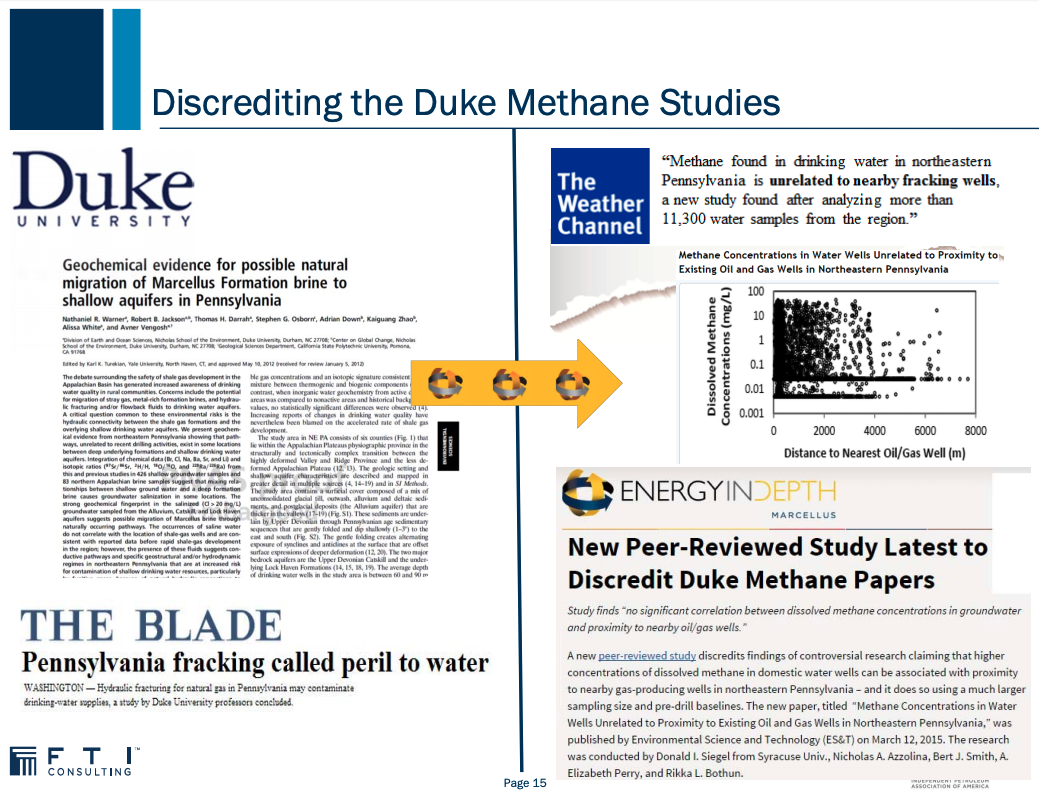
2011
DeSmog uncovered an industry memo that outlined the major oil and gas interests behind Energy In Depth including companies such as BP, Halliburton, Chevron, Shell, and XTO Energy (now owned by ExxonMobil).
The 2009 memo describes Energy In Depth as a “major initiative to respond to […] attacks” and to devise and circulate ‘coordinated messages’ using ‘new communications tools that are becoming the pathway of choice in national political campaigns.’” The memo states:
“The ‘Energy In Depth’ project would not be possible without the early financial commitments of: El Paso Corporation, XTO Energy, Occidental Petroleum, BP, Anadarko, Marathon, EnCana, Chevron, Talisman, Shell, API, IPAA, Halliburton, Schlumberger and the Ohio Oil and Gas Association.”
View the full memo, dated June 2009, below:
January 2011
As reported at DeSmog, shortly after the release of the award-winning documentary Gasland was released, Energy In Depth launched a public relations offensive against the film.56Emma Pullman. “Industry Groups Fight Dirty Against Oscar-Nominated Hydraulic Fracturing Documentary ‘Gasland’,” DeSmog, January 25, 2011.
A 2015 presentation made by FTI Consulting to the Tennessee Oil and Gas Associations outlines how they viewed Energy in Depth’s attack on Gasland as a success:
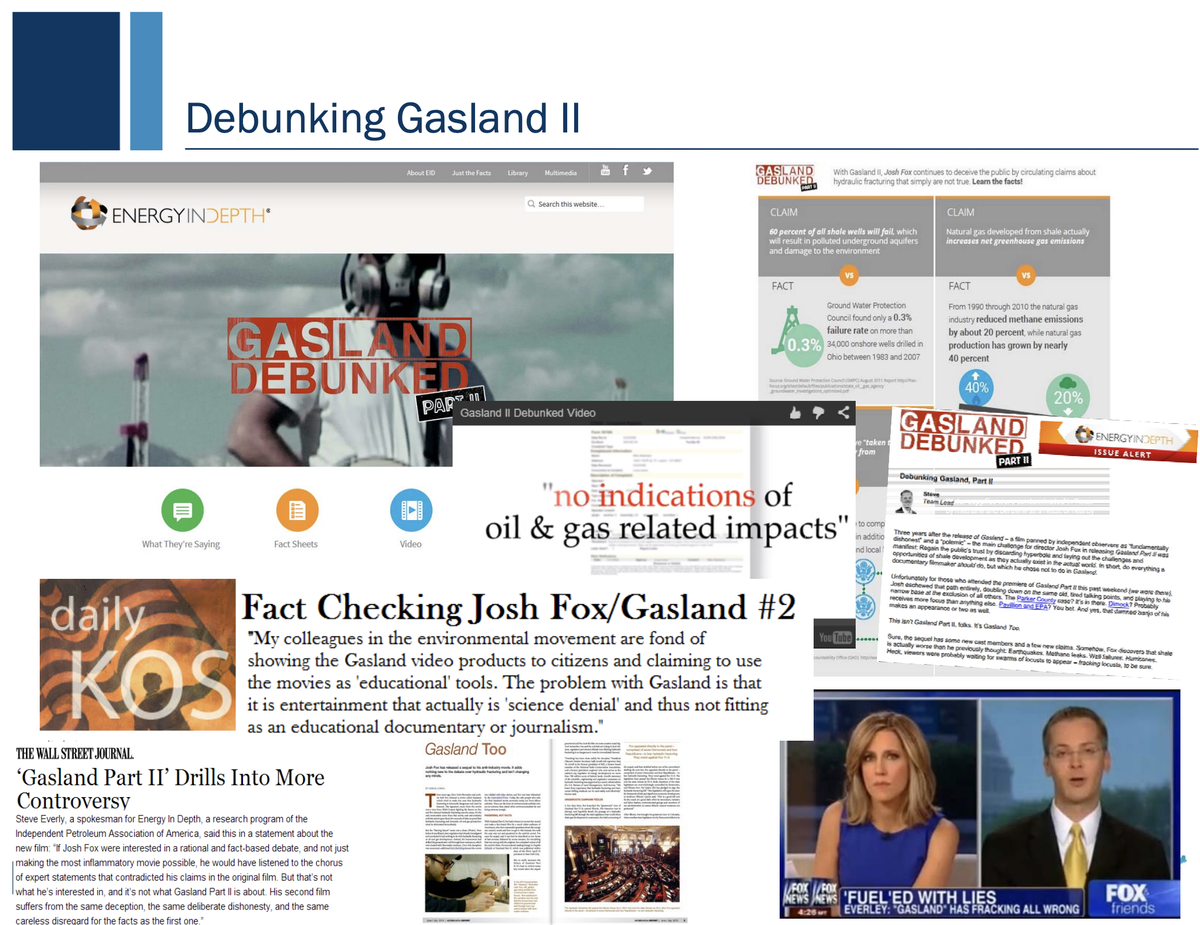
Energy In Depth also goes on to take credit for launching “Truthland” to combat Gasland. Lee Fang reported in The Nation that data from 990 tax forms had revealed Truthland was funded with a $1 million grant from America’s Natural Gas Alliance (ANGA), “a consortium of fracking firms including Devon Energy, Apache, Noble Energy, Range Resources, XTO Energy, Southwestern Energy and Pioneer Natural Resources, among others.” Ben Nelson of LittleSis reported that the Truthland website was briefly registered to the Oklahoma office of Chesapeake energy before the registration was changed and hidden behind a proxy.57Lee Fang. “The Fracking Industry’s Dishonest Response to ‘Gasland’,” The Nation, November 18, 2013. Archived September 20, 2019. Archive.fo URL: https://archive.fo/TUCub
Below is a screenshot of the Energy In Depth/FTI Consulting slide taking credit for the campaign:
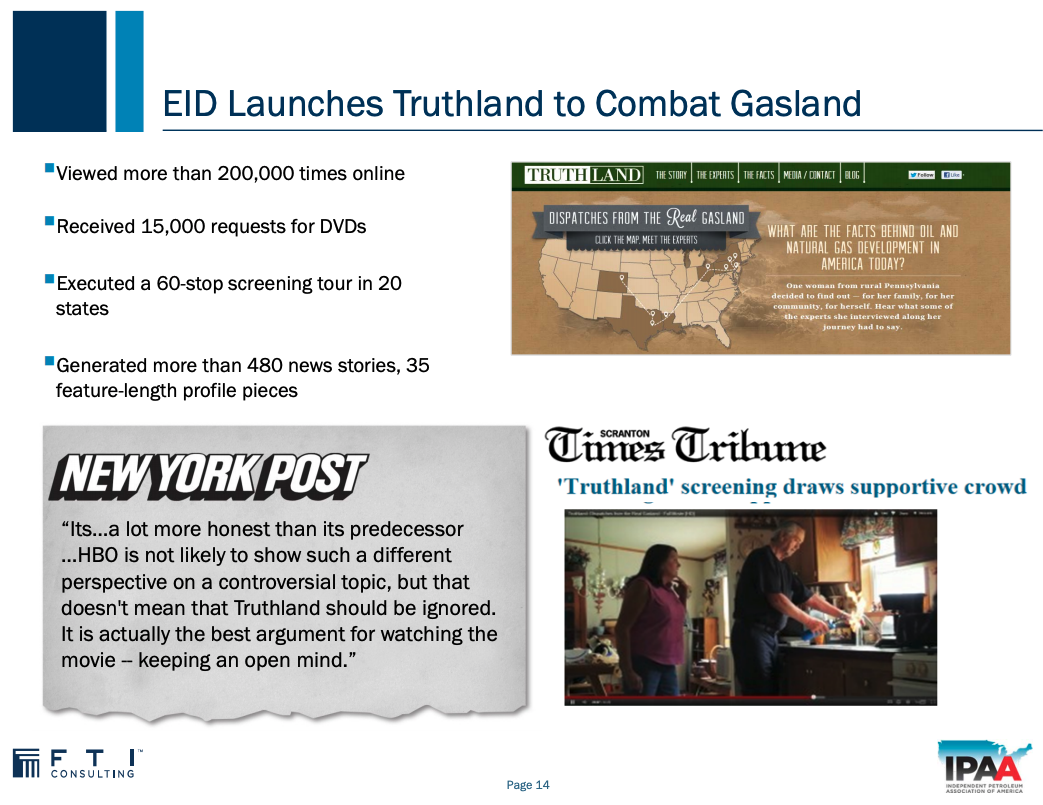
Related Organizations
EID maintains numerous state-level affiliates:
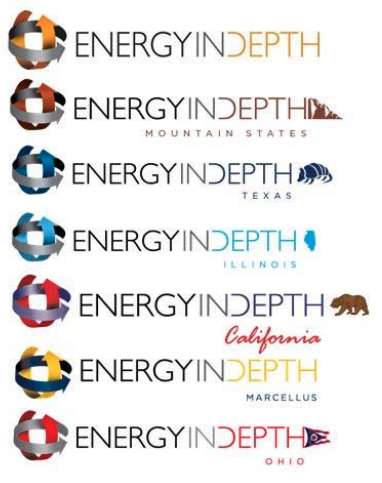
- FTI Consulting — Co-Launched EID with IPAA
- Independent Petroleum Association of America (IPAA)
- FD Americas Public Affairs — Originally registered EID website. A subsidiary of FTI Consulting.58Kevin Grandia. “Who are the spindoctors behind the attack on Gasland?” DeSmog, June 22, 2010.
Energy Resource Information Centre (Australia)
According to an archive of the group’s now-defunct website, the Energy Resource Information Centre “promotes the natural gas industry and provides a fact based, evidence led source of information about natural gas exploration and development.”59“About Us,” Energy Resource Information Center. Archived June 22, 2017. Archive.fo URL: https://archive.fo/sGg6i
“We are funded by the natural gas industry, and make no secret of that fact.
“Our membership includes major exploration and production companies, along with companies that support the responsible development of Australia’s natural gas industry.
With support from industry participants, the Energy Resource Information Centre builds on the deep expertise of the US-based Energy In Depth campaign, the Shale Resource Centre Canada, and Shale Gas Europe.”
The website notes that “Resourcing for the Centre is provided by FTI Consulting, a global business advisory company.”
Shale Gas Europe
FTI Consulting noted in a report that it also runs the Shale Gas Europe campaign. According to an archive of the group’s now-defunct website:60“About Shale Gas Europe,” Shale Gas Europe. Archived January 6, 2014. Archive.fo URL: https://archive.fo/VyiSg
“The shale gas debate in Europe is extremely important for the future of our energy supply. It is therefore essential that the debate is balanced, informative and engaging to allow the public to come to their own conclusions on the issue.
As a result, the industry decided to set-up a dedicated resource centre that is open to anyone who wants to understand more about shale gas, tight gas and coalbed methane. The secretariat of Shale Gas Europe is managed by FTI Consulting.
Launched in 2012, this platform will bring together industry, experts and academics to collect, share and communicate the interesting science and technology involved in shale gas exploration. It will also show the facts about the potential of responsibly developing Europe’s onshore energy reserves of shale gas.”
Energy Resource Information Centre (Australia)
According to an archive of the group’s now-defunct website, the Energy Resource Information Centre “promotes the natural gas industry and provides a fact based, evidence led source of information about natural gas exploration and development.”61“About Us,” Energy Resource Information Center. Archived June 22, 2017. Archive.fo URL: https://archive.fo/sGg6i
“We are funded by the natural gas industry, and make no secret of that fact.
“Our membership includes major exploration and production companies, along with companies that support the responsible development of Australia’s natural gas industry.
With support from industry participants, the Energy Resource Information Centre builds on the deep expertise of the US-based Energy In Depth campaign, the Shale Resource Centre Canada, and Shale Gas Europe.”
The website notes that “Resourcing for the Centre is provided by FTI Consulting, a global business advisory company.”
Contact & Address
EID listed the following on its web contact form, as of September 2019:62“CONTACT US,” Energy In Depth. Archived September 23, 2019. Archive.fo URL:https://archive.fo/wxdYD
Address
1201 15th Street NW
Suite 300
Washington, DC 20005Phone:
(202)346-8879
Social Media
Other Resources
- “Energy In Depth,” Sourcewatch.
- “Energy in Depth – The Gas Roots,” Scribd.
- “BIG OIL FRONT GROUP POURED MILLIONS INTO LOBBY AGAINST FRACKING REGULATION,” PolluterWatch, February 18, 2011.
Resources
- 1“Managing Aboveground Risks: Experience from the United States,” FTI Consulting, October 2014. Archived .pdf on file at DeSmog.
- 2Lisa Graves. “‘Energy In Depth’ – A Reporters’ Guide to Its Founding, Funding, and Flacks,” PR Watch, December 28, 2012.
- 3Brendan DeMelle. “‘Energy In Depth’ Was Created By Major Oil and Gas Companies According to Industry Memo,” DeSmog, February 17, 2011.
- 4“Managing Aboveground Risks: Experience from the United States,” FTI Consulting, October 2014. Archived .pdf on file at DeSmog.
- 5Brendan DeMelle. “‘Energy In Depth’ Was Created By Major Oil and Gas Companies According to Industry Memo,” DeSmog, February 17, 2011.
- 6Brendan DeMelle. “‘Energy In Depth’ Was Created By Major Oil and Gas Companies According to Industry Memo,” DeSmog, February 17, 2011.
- 7Emma Pullman. “Industry Groups Fight Dirty Against Oscar-Nominated Hydraulic Fracturing Documentary ‘Gasland’,” DeSmog, January 25, 2011.
- 8Kevin Grandia. “Who are the spindoctors behind the attack on Gasland?” DeSmog, June 22, 2010.
- 9“FD Americas Public Affairs,” FD Americas Public Affairs. Archived August 4, 2010. Archive.fo URL: https://archive.fo/BtcO9
- 10“Expanding Global Capabilities: Annual Report 2011” (PDF), FTI Consulting. Archived .pdf on file at DeSmog.
- 11“THE CLIMATE BENEFITS OF NATURAL GAS,” Energy In Depth. Archived September 20, 2019. Archive.fo URL: https://archive.fo/DlrJk
- 12Brendan DeMelle. “‘Energy In Depth’ Was Created By Major Oil and Gas Companies According to Industry Memo,” DeSmog, February 17, 2011.
- 13“Nicole (Jacobs) Schomburg,” LinkedIn. Accessed September 21, 2019. Archived .pdf on file at DeSmog.
- 14Steve Horn. “Trump Names Industry Lobbyist and Climate Science Denier Mike Catanzaro as Top White House Energy Aide,” DeSmog, February 8, 2017.
- 15“Steve Everley,” FTI Consulting. Archived September 20, 2019.
- 16“Dave Quast,” FTI Consulting. Archived September 20, 2019.
- 17“FTI Consulting adds 4 senior hires to its Australian team,” Consultancy.uk, October 17, 2014. Archived September 19, 2019. Archive.fo URL:https://archive.fo/JWxW0
- 18“Coal seam gas debate: Dayne Pratzky vs Steve Wright,” ABC, March 18, 2015. Archived September 20, 2019. Archive.fo URL: https://archive.fo/FarLw
- 19Katie Brown. “The American Shale Boom: Looking Back and Forward” (PDF), FTI Consulting, May 21, 2015. Archived .pdf on file at DeSmog.
- 20“Environmental Issues Affecting Midstream and Downstream Oil & Gas Development” (PDF), Joint presentation of HULL and Blank Rome LLP, October 23, 2013. Archived .pdf on file at DeSmog.
- 21“SENATOR TOM LIBOUS TALKS TO EID MARCELLUS,” Energy In Depth, March 5, 2012. Archived September 20, 2019.
- 22Sharon Kelly. “In Some Pennsylvania Pro-Fracking Corners, Name-calling, False Claims, and Swastika-Laden Images Circulate,” DeSmog, May 1, 2019.
- 23Sharon Kelly. “In Some Pennsylvania Pro-Fracking Corners, Name-calling, False Claims, and Swastika-Laden Images Circulate,” DeSmog, May 1, 2019.
- 24Sharon Kelly. “In Some Pennsylvania Pro-Fracking Corners, Name-calling, False Claims, and Swastika-Laden Images Circulate,” DeSmog, May 1, 2019.
- 25“Simon Lomax,” Independence Institute. Archived August 13, 2019. Archive.fo URL: https://archive.fo/c5rJR
- 26Pamela King. “Western energy group launches publication,” E&E News. January 25, 2017. Archived .pdf on file at DeSmog.
- 27“Chris Broyles,” FTI Consulting. Archived September 23, 2019. Archive.fo URL:https://archive.fo/vsrWZ
- 28“About Us,” Western Wire. Archived September 19, 2019. Archive.fo URL: https://archive.fo/Sw8r1
- 29“Who We Are,” Energy In Depth Northeast Marcellus Initiative. Archived december 6, 2012. Archive.fo URL: https://archive.fo/D9L8v
- 30Jeff Eshelman. “‘Air’ Apparent: Activists Roll Out Widely Discredited Shale Researchers to Attack Low-Carbon Hydrogen Technology,” Energy in Depth, August 16, 2021. Archived August 23, 2021. Archive URL: https://archive.ph/FgAhI
- 31Blaine Friedlander. “Touted as clean, ‘blue’ hydrogen may be worse than gas or coal,” Cornell Chronicle, August 12, 2021. Archived August 24, 2021. Archive URL:https://archive.ph/f2Hhf
- 32Justin Mikulka. “As Subsidies Roll in, the Fossil Fuel Industry Is Winning Efforts to Cast Blue Hydrogen as a ‘Clean’ Fuel,” DeSmog, August 23, 2021.
- 33“Jason Kenney’s Inquiry Into ‘Anti-Alberta’ Activities Publishes Report Attacking Climate Change Science,” PressProgress, January 14, 2021. Archived February 18, 2021. Archive URL: https://archive.vn/mQnRF
- 34Jason Herring. “Extended deadline for inquiry into anti-Alberta energy campaigns draws criticism,” Calgary Herald, January 31, 2021. Archived February 18, 2021. Archive URL: https://archive.vn/Tci8p
- 35Sarah Rieger. “Inquiry into alleged anti-Alberta energy campaigns doesn’t have time to fact-check statements: commissioner,” CBC News, September 16, 2020.
- 36Jennie Russell and Charles Rusnell. “Critics denounce ‘climate-change denialism’ reports commissioned by Alberta inquiry,” CBC News, January 14, 2021. Archive URL: https://archive.vn/meVIX
- 37“’Textbook Climate Denialism’: A Submission to the Public Inquiry into Anti-Alberta Energy Campaigns,” ABLaw.ca, January 14, 2021. Archived February 18, 2021. PDF version. Archive URL: https://archive.vn/8FY15
- 38Paul D. Thacker. “Fossil Fuel Giants Claim To Support Climate Science, Yet Still Fund Denial,” Huffington Post, December 24, 2019. Archived January 7, 2020. Archive.is URL: http://archive.is/wip/9vgkT
- 39Paul D. Thacker. “Fossil Fuel Giants Claim To Support Climate Science, Yet Still Fund Denial,” Huffington Post, December 24, 2019. Archived January 7, 2020. Archive.is URL: http://archive.is/wip/9vgkT
- 40Paul D. Thacker. “Fossil Fuel Giants Claim To Support Climate Science, Yet Still Fund Denial,” Huffington Post, December 24, 2019. Archived January 7, 2020. Archive.is URL: http://archive.is/wip/9vgkT
- 41William Allison. “New Report Shows No Link Between Fracking And Health Problems” (PDF), Energy In Depth Health & Safety, September 17, 2019. Archived September 23, 2019. Archive.fo URL: https://archive.fo/06cKu
- 42“POTENTIAL HUMAN HEALTH EFFECTS ASSOCIATED WITH UNCONVENTIONAL OIL AND GAS DEVELOPMENT: A SYSTEMATIC REVIEW OF THE EPIDEMIOLOGY LITERATURE” (PDF), HEI-Energy Research Comittee, September 2019. Archived .pdf on file at DeSmog.
- 43“Sponsors,” HEI Energy. Archived September 23, 2019. Archive.fo URL: https://archive.fo/RnK6N
- 44“Get the Facts on the Climate Benefits of #NatGas at EID’s New Microsite, Energy In Depth Climate & Environment,” Tweet by @EnergyInDepth, November 10, 2017. Archived .png on file at DeSmog.
- 45“THE CLIMATE BENEFITS OF NATURAL GAS,” Energy In Depth. Archived September 20, 2019. Archive.fo URL: https://archive.fo/DlrJk
- 46“AN ORCHESTRATED CAMPAIGN,” EnergyInDepth Climate & Environment. Archived September 20, 2019. Archive.fo URL: https://archive.fo/cWNcd
- 47“WHAT EXPERTS SAY,” EnergyInDepth Climate & Environment. Archived September 20, 2019. Archive.fo URL:https://archive.fo/LFlDs
- 48Simon Davis-Cohen. “Fossil Fuel Misinformation Helps Quash Community Effort to Ban Fracking in Youngstown, Ohio,” DeSmog, October 18, 2017.
- 49“CELDF’S WORST YEAR YET: OHIO SUPREME COURT REJECTS YOUNGSTOWN ‘BILL OF RIGHTS’ APPEAL,” Energy In Depth, October 9, 2017. Archive.fo URL: https://archive.fo/aNWeD
- 50Steve Horn. “Fracking Fans Use Intelligence Report to Revive Baseless Claim Russia Funds U.S. Anti-Fracking Movement,” DeSmog, January 10, 2017.
- 51Seth Whitehead. “REPORT: RUSSIA BACKED ANTI-FRACKING PROPAGANDA IN ATTEMPT TO UNDERMINE U.S. INDUSTRY,” Energ In Depth, January 9, 2017. Archived September 20, 2019. Archive.fo URL: https://archive.fo/ie267
- 52“Pennsylvania fracking called peril to water,” The Toledo Blade, July 9, 2012. Archived September 20, 2019. Archive.fo URL: https://archive.fo/yqaEv
- 53“NEW PEER-REVIEWED STUDY LATEST TO DISCREDIT DUKE METHANE PAPERS,” Energy In Depth, March 25, 2015. Archived September 20, 2019. Archive.fo URL: https://archive.fo/5l78I
- 54
- 55
- 56Emma Pullman. “Industry Groups Fight Dirty Against Oscar-Nominated Hydraulic Fracturing Documentary ‘Gasland’,” DeSmog, January 25, 2011.
- 57Lee Fang. “The Fracking Industry’s Dishonest Response to ‘Gasland’,” The Nation, November 18, 2013. Archived September 20, 2019. Archive.fo URL: https://archive.fo/TUCub
- 58Kevin Grandia. “Who are the spindoctors behind the attack on Gasland?” DeSmog, June 22, 2010.
- 59“About Us,” Energy Resource Information Center. Archived June 22, 2017. Archive.fo URL: https://archive.fo/sGg6i
- 60“About Shale Gas Europe,” Shale Gas Europe. Archived January 6, 2014. Archive.fo URL: https://archive.fo/VyiSg
- 61“About Us,” Energy Resource Information Center. Archived June 22, 2017. Archive.fo URL: https://archive.fo/sGg6i
- 62“CONTACT US,” Energy In Depth. Archived September 23, 2019. Archive.fo URL:https://archive.fo/wxdYD


